Changes in Urban Planning in Response to Pandemics: A Comparative Review from H1N1 to COVID-19 (2009–2022)
Abstract
1. Introduction
2. Methods
2.1. Paper Searching, Screening, and Selection
2.1.1. Data Collection and Identification
2.1.2. Screening and Eligibility
2.2. Bibliometric Analysis
2.3. Detailed Analysis
3. Results
3.1. General Statistics of Publications
3.1.1. Annual Publications and Citations
3.1.2. Author Keywords
3.2. Network Analysis of Publications
3.2.1. Keywords Co-Occurrence Analysis
- -
- 2009–2015 (in color blue to grey)
- -
- 2016–2019 (in color flesh to salmon pink)
- -
- 2020–2022 (in color red)
3.2.2. Co-Citation Analysis
3.3. Detailed Analysis of Publications
3.3.1. Geographic Scope and Research Scale
3.3.2. Study Methods
3.3.3. Study Theme
4. Discussion
4.1. Study Themes and Identified Theories
4.2. Comparisons of H1N1 and COVID-19 Responses
4.2.1. Change-1: From Stages of “In-Pandemic” and “Pre-Pandemic” to the Stage of “Post-Pandemic”
4.2.2. Change-2: From Global, National, to Local
4.2.3. Change-3: The Prominent Role of Urban Built Environment
5. Conclusions
Author Contributions
Funding
Institutional Review Board Statement
Informed Consent Statement
Data Availability Statement
Conflicts of Interest
References
- Statement on the Fifteenth Meeting of the IHR (2005) Emergency Committee on the COVID-19 Pandemic. Available online: https://www.who.int/news/item/05-05-2023-statement-on-the-fifteenth-meeting-of-the-international-health-regulations-(2005)-emergency-committee-regarding-the-coronavirus-disease-(covid-19)-pandemic (accessed on 5 May 2023).
- Florida, R.; Rodriguez-Pose, A.; Storper, M. Cities in a Post-COVID World. Urban Stud. 2021, 60, 00420980211018072. [Google Scholar] [CrossRef]
- Bereitschaft, B.; Scheller, D. How Might the COVID-19 Pandemic Affect 21st Century Urban Design, Planning, and Development? Urban Sci. 2020, 4, 56. [Google Scholar] [CrossRef]
- Ibert, O.; Baumgart, S.; Siedentop, S.; Weith, T. Planning in the Face of Extraordinary Uncertainty: Lessons from the COVID-19 Pandemic. Plan. Pract. Res. 2022, 37, 1–12. [Google Scholar] [CrossRef]
- Wang, J. Vision of China’s Future Urban Construction Reform: In the Perspective of Comprehensive Prevention and Control for Multi Disasters. Sustain. Cities Soc. 2021, 64, 102511. [Google Scholar] [CrossRef] [PubMed]
- Design in the Age of Pandemics. Available online: https://www.curbed.com/2020/3/17/21178962/design-pandemics-coronavirus-quarantine (accessed on 17 May 2022).
- Saunders-Hastings, P.; Krewski, D. Reviewing the History of Pandemic Influenza: Understanding Patterns of Emergence and Transmission. Pathogens 2016, 5, 66. [Google Scholar] [CrossRef] [PubMed]
- Rice, G. How Reminders of the 1918-19 Pandemic Helped Australia and New Zealand Respond to COVID-19. J. Glob. Hist. 2020, 15, 421–433. [Google Scholar] [CrossRef]
- Nichols, C.; Bristow, N.; Ewing, E.; Gabriel, J.; Montoya, B.; Outka, E. Reconsidering the 1918-19 Influenza Pandemic in the Age of COVID-19. J. Gilded AGE Progress. Era 2020, 19, 642–672. [Google Scholar] [CrossRef]
- Machado, C.; Ribeiro, D.; Viana, A. Public Health in Times of Crisis: An Overlooked Variable in City Management Theories? Sustain. Cities Soc. 2021, 66, 102671. [Google Scholar] [CrossRef]
- Harris, P.; Harris-Roxas, B.; Prior, J.; Morrison, N.; McIntyre, E.; Frawley, J.; Adams, J.; Bevan, W.; Haigh, F.; Freeman, E.; et al. Respiratory Pandemics, Urban Planning and Design: A Multidisciplinary Rapid Review of the Literature. Cities 2022, 127, 103767. [Google Scholar] [CrossRef]
- Morens, D.; Fauci, A. The 1918 Influenza Pandemic: Insights for the 21st Century. J. Infect. Dis. 2007, 195, 1018–1028. [Google Scholar] [CrossRef]
- SARS: How a Global Epidemic Was Stopped. Available online: https://apps.who.int/iris/handle/10665/207501 (accessed on 1 August 2022).
- Global Health Security, with Special Emphasis on MERS-CoV and A(H5N1). Available online: https://apps.who.int/iris/handle/10665/250483 (accessed on 12 September 2022).
- Dawood, F.S.; Iuliano, A.D.; Reed, C.; Meltzer, M.I.; Shay, D.K.; Cheng, P.Y.; Bandaranayake, D.; Breiman, R.F.; Brooks, W.A.; Buchy, P.; et al. Estimated global mortality associated with the first 12 months of 2009 pandemic influenza A H1N1 virus circulation: A modelling study. Lancet Infect. Dis. 2012, 12, 687–695. [Google Scholar] [CrossRef] [PubMed]
- Doshi, P. The Elusive Definition of Pandemic Influenza. Bull. World Health Organ. 2011, 89, 532–538. [Google Scholar] [CrossRef] [PubMed]
- Implementation of the International Health Regulations. 2005. Available online: https://apps.who.int/gb/ebwha/pdf_files/WHA64/A64_10-en.pdf?ua=1 (accessed on 15 May 2021).
- Fraser, C.; Donnelly, C.; Cauchemez, S.; Hanage, W.; Van Kerkhove, M.; Hollingsworth, T.; Griffin, J.; Baggaley, R.; Jenkins, H.; Lyons, E.; et al. Pandemic Potential of a Strain of Influenza A (H1N1): Early Findings. Science 2009, 324, 1557–1561. [Google Scholar] [CrossRef] [PubMed]
- Yang, Y.; Sugimoto, J.; Halloran, M.; Basta, N.; Chao, D.; Matrajt, L.; Potter, G.; Kenah, E.; Longini, I. The Transmissibility and Control of Pandemic Influenza A (H1N1) Virus. Science 2009, 326, 729–733. [Google Scholar] [CrossRef]
- World Health Organization. WHO Guidance on Preparing for National Response to Health Emergencies and Disasters. 2021. Available online: https://apps.who.int/iris/bitstream/handle/10665/350838/9789240037182-eng.pdf?sequence=1 (accessed on 6 March 2022).
- Petersen, K.; Vakkalanka, S.; Kuzniarz, L. Guidelines for Conducting Systematic Mapping Studies in Software Engineering: An Update. Inf. Softw. Technol. 2015, 64, 1–18. [Google Scholar] [CrossRef]
- Dotsika, F.; Watkins, A. Identifying Potentially Disruptive Trends by Means of Keyword Network Analysis. Technol. Forecast. Soc. Change 2017, 119, 114–127. [Google Scholar] [CrossRef]
- van Eck, N.; Waltman, L. Software Survey: VOSviewer, a Computer Program for Bibliometric Mapping. Scientometrics 2010, 84, 523–538. [Google Scholar] [CrossRef]
- Perianes-Rodriguez, A.; Waltman, L.; van Eck, N.J. Constructing Bibliometric Networks: A Comparison between Full and Fractional Counting. J. Informetr. 2016, 10, 1178–1195. [Google Scholar] [CrossRef]
- Noack, A. Energy Models for Graph Clustering. J. Graph Algorithms Appl. 2007, 11, 453–480. [Google Scholar] [CrossRef]
- Ahuvia, A. Traditional, Interpretive, and Reception Based Content Analyses: Improving the Ability of Content Analysis to Address Issues of Pragmatic and Theoretical Concern. Soc. Indic. Res. 2001, 54, 139–172. [Google Scholar] [CrossRef]
- Jacobs, J. The Death and Life of Great American Cities; Penguin: Harmondsworth, UK, 1992. [Google Scholar]
- Sharifi, A.; Khavarian-Garmsir, A. The COVID-19 Pandemic: Impacts on Cities and Major Lessons for Urban Planning, Design, and Management. Sci. Total Environ. 2020, 749, 142391. [Google Scholar] [CrossRef] [PubMed]
- Hamidi, S.; Sabouri, S.; Ewing, R. Does Density Aggravate the COVID-19 Pandemic? Early Findings and Lessons for Planners. J. Am. Plann. Assoc. 2020, 86, 495–509. [Google Scholar] [CrossRef]
- Megahed, N.; Ghoneim, E. Antivirus-Built Environment: Lessons Learned from COVID-19 Pandemic. Sustain. Cities Soc. 2020, 61, 102350. [Google Scholar] [CrossRef]
- Kraemer, M.; Yang, C.; Gutierrez, B.; Wu, C.; Klein, B.; Pigott, D.; du Plessis, L.; Faria, N.; Li, R.; Hanage, W.; et al. The Effect of Human Mobility and Control Measures on the COVID-19 Epidemic in China. Science 2020, 368, 493–497. [Google Scholar] [CrossRef] [PubMed]
- Chinazzi, M.; Davis, J.; Ajelli, M.; Gioannini, C.; Litvinova, M.; Merler, S.; Piontti, A.; Mu, K.; Rossi, L.; Sun, K.; et al. The Effect of Travel Restrictions on the Spread of the 2019 Novel Coronavirus (COVID-19) Outbreak. Science 2020, 368, 395–400. [Google Scholar] [CrossRef] [PubMed]
- Tian, H.; Liu, Y.; Li, Y.; Wu, C.; Chen, B.; Kraemer, M.; Li, B.; Cai, J.; Xu, B.; Yang, Q.; et al. An Investigation of Transmission Control Measures during the First 50 Days of the COVID-19 Epidemic in China. Science 2020, 368, 638–642. [Google Scholar] [CrossRef] [PubMed]
- Qualls, N.; Levitt, A.; Kanade, N.; Wright-Jegede, N.; Dopson, S.; Biggerstaff, M.; Reed, C.; Uzicanin, A. Community Mitigation Guidelines to Prevent Pandemic Influenza—United States, 2017. MMWR Recomm. Rep. 2017, 66, 1–34. [Google Scholar] [CrossRef]
- Mollalo, A.; Vahedi, B.; Rivera, K. GIS-Based Spatial Modeling of COVID-19 Incidence Rate in the Continental United States. Sci. Total. Environ. 2020, 728, 138884. [Google Scholar] [CrossRef]
- Wang, C.; Li, Z.; Mathews, M.; Praharaj, S.; Karna, B.; Solis, P. The Spatial Association of Social Vulnerability with COVID-19 Prevalence in the Contiguous United States. Int. J. Environ. Health Res. 2022, 32, 1147–1154. [Google Scholar] [CrossRef]
- Hanson, H.; Wickenberg, B.; Olsson, J. Working on the Boundaries-How Do Science Use and Interpret the Nature-Based Solution Concept? Land Use Policy 2019, 90, 104302. [Google Scholar] [CrossRef]
- Mao, L.; Bian, L. Spatial-Temporal Transmission of Influenza and Its Health Risks in an Urbanized Area. Comput. Environ. Urban Syst. 2010, 34, 204–215. [Google Scholar] [CrossRef] [PubMed]
- Holmberg, M.; Lundgren, B. Framing Post-Pandemic Preparedness: Comparing Eight European Plans. Glob. Public Health 2018, 13, 99–114. [Google Scholar] [CrossRef] [PubMed]
- Li, L.; Zhang, S.; Wang, J.; Yang, X.; Wang, L. Governing Public Health Emergencies during the Coronavirus Disease Outbreak: Lessons from Four Chinese Cities in the First Wave. Urban Stud. 2021. [Google Scholar] [CrossRef]
- Sharp, A.; Jain, V.; Alimi, Y.; Bausch, D. Policy and Planning for Large Epidemics and Pandemics—Challenges and Lessons Learned from COVID-19. Curr. Opin. Infect. Dis. 2021, 34, 393–400. [Google Scholar] [CrossRef]
- Kummitha, R. Smart Technologies for Fighting Pandemics: The Techno-and Human-Driven Approaches in Controlling the Virus Transmission. Gov. Inf. Q. 2020, 37, 101481. [Google Scholar] [CrossRef]
- Sharifi, A.; Khavarian-Garmsir, A.; Kummitha, R. Contributions of Smart City Solutions and Technologies to Resilience against the COVID-19 Pandemic: A Literature Review. Sustainability 2021, 13, 8018. [Google Scholar] [CrossRef]
- Wirtz, B.; Muller, W.; Weyerer, J. Digital Pandemic Response Systems: A Strategic Management Framework Against COVID-19. Int. J. Public Adm. 2021, 44, 896–906. [Google Scholar] [CrossRef]
- Yuan, Z.; Xiao, Y.; Dai, Z.; Huang, J.; Zhang, Z.; Chen, Y. Modelling the Effects of Wuhan’s Lockdown during COVID-19, China. Bull. World Health Organ. 2020, 98, 484–494. [Google Scholar] [CrossRef]
- Ghahramani, M.; Pilla, F. Leveraging Artificial Intelligence to Analyze the COVID-19 Distribution Pattern Based on Socio-Economic Determinants. Sustain. Cities Soc. 2021, 69, 102848. [Google Scholar] [CrossRef]
- Simsek, M.; Kantarci, B. Artificial Intelligence-Empowered Mobilization of Assessments in COVID-19-like Pandemics: A Case Study for Early Flattening of the Curve. Int. J. Environ. Res. Public Health 2020, 17, 3437. [Google Scholar] [CrossRef]
- Pang, J.; Huang, Y.; Xie, Z.; Li, J.; Cai, Z. Collaborative City Digital Twin for the COVID-19 Pandemic: A Federated Learning Solution. Tsinghua Sci. Technol. 2021, 26, 759–771. [Google Scholar] [CrossRef]
- Xu, B.; Tian, H.; Sabel, C.; Xu, B. Impacts of Road Traffic Network and Socioeconomic Factors on the Diffusion of 2009 Pandemic Influenza A (H1N1) in Mainland China. Int. J. Environ. Res. Public Health 2019, 16, 1223. [Google Scholar] [CrossRef] [PubMed]
- Burger, R.; Chowell, G.; Mulet, P.; Villada, L. Modelling the spatial-temporal progression of the 2009 A/H1N1 influenza pandemic in Chile. Math. Biosci. Eng. 2016, 13, 43–65. [Google Scholar] [CrossRef]
- Prieto, J.; Malagon, R.; Gomez, J.; Leon, E. Urban Vulnerability Assessment for Pandemic Surveillance-The COVID-19 Case in Bogota, Colombia. Sustainability 2021, 13, 3402. [Google Scholar] [CrossRef]
- Bin Kashem, S.; Baker, D.; Gonzalez, S.; Lee, C. Exploring the Nexus between Social Vulnerability, Built Environment, and the Prevalence of COVID-19: A Case Study of Chicago. Sustain. Cities Soc. 2021, 75, 103261. [Google Scholar] [CrossRef]
- Niu, Q.; Wu, W.; Shen, J.; Huang, J.; Zhou, Q. Relationship between Built Environment and COVID-19 Dispersal Based on Age Stratification: A Case Study of Wuhan. Int. J. Environ. Res. Public Health 2021, 18, 7563. [Google Scholar] [CrossRef]
- Huang, Y.; Li, R. The Lockdown, Mobility, and Spatial Health Disparities in COVID-19 Pandemic: A Case Study of New York City. Cities 2022, 122, 103549. [Google Scholar] [CrossRef] [PubMed]
- Li, X.; Zhou, L.; Jia, T.; Peng, R.; Fu, X.; Zou, Y. Associating COVID-19 Severity with Urban Factors: A Case Study of Wuhan. Int. J. Environ. Res. Public Health 2020, 17, 6712. [Google Scholar] [CrossRef]
- Cheshmehzangi, A. Revisiting the Built Environment: 10 Potential Development Changes and Paradigm Shifts Due to COVID-19. J. Urban Manag. 2021, 10, 166–175. [Google Scholar] [CrossRef]
- Andres, L.; Bryson, J.; Moawad, P. Temporary Urbanisms as Policy Alternatives to Enhance Health and Well-Being in the Post-Pandemic City. Curr. Environ. Health Rep. 2021, 8, 167–176. [Google Scholar] [CrossRef]
- Nieuwenhuijsen, M. New Urban Models for More Sustainable, Liveable and Healthier Cities Post Covid19; Reducing Air Pollution, Noise and Heat Island Effects and Increasing Green Space and Physical Activity. Environ. Int. 2021, 157, 106850. [Google Scholar] [CrossRef]
- Pozoukidou, G.; Chatziyiannaki, Z. 15-Minute City: Decomposing the New Urban Planning Eutopia. Sustainability 2021, 13, 928. [Google Scholar] [CrossRef]
- Batty, M. The Post-Pandemic City: Speculation through Simulation. Cities 2022, 124, 103594. [Google Scholar] [CrossRef]
- Moglia, M.; Frantzeskaki, N.; Newton, P.; Pineda-Pinto, M.; Witheridge, J.; Cook, S.; Glackin, S. Accelerating a Green Recovery of Cities: Lessons from a Scoping Review and a Proposal for Mission-Oriented Recovery towards Post-Pandemic Urban Resilience. Dev. Built Environ. 2021, 7, 100052. [Google Scholar] [CrossRef]
- Ranjbari, M.; Esfandabadi, Z.; Zanetti, M.; Scagnelli, S.; Siebers, P.; Aghbashlo, M.; Peng, W.; Quatraro, F.; Tabatabaei, M. Three Pillars of Sustainability in the Wake of COVID-19: A Systematic Review and Future Research Agenda for Sustainable Development. J. Clean. Prod. 2021, 297, 126660. [Google Scholar] [CrossRef] [PubMed]
- Mouratidis, K.; Papagiannakis, A. COVID-19, Internet, and Mobility: The Rise of Telework, Telehealth, e-Learning, and e-Shopping. Sustain. Cities Soc. 2021, 74, 103182. [Google Scholar] [CrossRef] [PubMed]
- Jasinski, A. COVID-19 Pandemic Is Challenging Some Dogmas of Modern Urbanism. Cities 2022, 121, 103498. [Google Scholar] [CrossRef] [PubMed]
- Gomez, N. Planning for Social Distancing: How the Legacy of Historical Epidemics Shaped COVID-19′s Spread in Madrid. Urban Stud. 2022. [Google Scholar] [CrossRef]
- Moreno, C.; Allam, Z.; Chabaud, D.; Gall, C.; Pratlong, F. Introducing the “15-Minute City”: Sustainability, Resilience and Place Identity in Future Post-Pandemic Cities. Smart Cities 2021, 4, 93–111. [Google Scholar] [CrossRef]
- McCaw, J.; Glass, K.; Mercer, G.; McVernon, J. Pandemic Controllability: A Concept to Guide a Proportionate and Flexible Operational Response to Future Influenza Pandemics. J. Public Health 2014, 36, 5–12. [Google Scholar] [CrossRef] [PubMed]
- Mansnerus, E. Using Model-Based Evidence in the Governance of Pandemics. Sociol. Health Illn. 2013, 35, 280–291. [Google Scholar] [CrossRef]
- Crosier, A.; McVey, D.; French, J. “By Failing to Prepare You Are Preparing to Fail”: Lessons from the 2009 H1N1 “swine Flu” Pandemic. Eur. J. Public Health 2015, 25, 135–139. [Google Scholar] [CrossRef] [PubMed]
- WHO Coronavirus (COVID-19) Dashboard. Available online: https://covid19.who.int/ (accessed on 15 April 2023).
- Cantey, P.; Chuk, M.; Kohl, K.; Herrmann, J.; Weiss, P.; Graffunder, C.; Averhoff, F.; Kahn, E.; Painter, J. Public Health Emergency Preparedness: Lessons Learned About Monitoring of Interventions From the National Association of County and City Health Official’s Survey of Nonpharmaceutical Interventions for Pandemic H1N1. J. Public Health Manag. Pract. 2013, 19, 70–76. [Google Scholar] [CrossRef]
- Wei, Y.; Wang, J.; Song, W.; Xiu, C.; Ma, L.; Pei, T. Spread of COVID-19 in China: Analysis from a City-Based Epidemic and Mobility Model. Cities 2021, 110, 103010. [Google Scholar] [CrossRef] [PubMed]
- Chan, J.; Yuan, S.; Kok, K.; To, K.; Chu, H.; Yang, J.; Xing, F.; Liu, J.; Yip, C.; Poon, R.; et al. A Familial Cluster of Pneumonia Associated with the 2019 Novel Coronavirus Indicating Person-to-Person Transmission: A Study of a Family Cluster. Lancet 2020, 395, 514–523. [Google Scholar] [CrossRef] [PubMed]
- Acuto, M. COVID-19: Lessons for an Urban(izing) World. One Earth 2020, 2, 317–319. [Google Scholar] [CrossRef]
- Lee, B.; Haidari, L.; Lee, M. Modelling during an Emergency: The 2009 H1N1 Influenza Pandemic. Clin. Microbiol. Infect. 2013, 19, 1014–1022. [Google Scholar] [CrossRef]
- Chambers, J.; Barker, K.; Rouse, A. Reflections on the UK’s Approach to the 2009 Swine Flu Pandemic: Conflicts between National Government and the Local Management of the Public Health Response. Health Place 2012, 18, 737–745. [Google Scholar] [CrossRef]
- Guo, Y.; Chen, J.; Liu, Z. Government Responsiveness and Public Acceptance of Big-Data Technology in Urban Governance: Evidence from China during the COVID-19 Pandemic. Cities 2022, 122, 103536. [Google Scholar] [CrossRef]
- Haraguchi, M.; Nishino, A.; Kodaka, A.; Allaire, M.; Lall, U.; Kuei-Hsien, L.; Onda, K.; Tsubouchi, K.; Kohtake, N. Human Mobility Data and Analysis for Urban Resilience: A Systematic Review. Environ. Plan. B Urban Anal. City Sci. 2022, 49, 1507–1535. [Google Scholar] [CrossRef]
- Hoffman, L. The Return of the City-State: Urban Governance and the New York City H1N1 Pandemic. Sociol. Health Illn. 2013, 35, 255–267. [Google Scholar] [CrossRef]
- World Health Organization. Pandemic Influenza Risk Management: A WHO Guide to Inform and Harmonize National and International Pandemic Preparedness and Response. Available online: https://apps.who.int/iris/handle/10665/259893 (accessed on 3 January 2023).
- He, J.; Zhang, Y. Urban Epidemic Governance: An Event System Analysis of the Outbreak and Control of COVID-19 in Wuhan, China. Urban Stud. 2022, 00420980211064136. [Google Scholar] [CrossRef]
- Li, B.; Peng, Y.; He, H.; Wang, M.; Feng, T. Built Environment and Early Infection of COVID-19 in Urban Districts: A Case Study of Huangzhou. Sustain. Cities Soc. 2021, 66, 102685. [Google Scholar] [CrossRef]
- Alizadeh, H.; Sharifi, A. Social Resilience Promotion Factors during the COVID-19 Pandemic: Insights from Urmia, Iran. Urban Sci. 2022, 6, 14. [Google Scholar] [CrossRef]
- Fior, M.; Mpampatsikos, V. COVID-19 and Estimates of Actual Deaths in Italy. Scenarios for Urban Planning in Lombardy. J. Urban Manag. 2021, 10, 275–301. [Google Scholar] [CrossRef]
- Gössling, S.; Scott, D.; Hall, C.M. Pandemics, tourism and global change: A rapid assessment of COVID-19. J. Sustain. Tour. 2021, 29, 48–52. [Google Scholar] [CrossRef]
- Pulighe, G.; Lupia, F. Food First: COVID-19 Outbreak and Cities Lockdown a Booster for a Wider Vision on Urban Agriculture. Sustainability 2020, 12, 5012. [Google Scholar] [CrossRef]
- Wang, J.; Yang, Y.; Peng, J.; Yang, L.; Gou, Z.; Lu, Y. Moderation Effect of Urban Density on Changes in Physical Activity during the Coronavirus Disease 2019 Pandemic. Sustain. Cities Soc. 2021, 72, 103058. [Google Scholar] [CrossRef]
- Pakoz, M.; Isik, M. Rethinking Urban Density, Vitality and Healthy Environment in the Post-Pandemic City: The Case of Istanbul. Cities 2022, 124, 103598. [Google Scholar] [CrossRef]
- Pouso, S.; Borja, A.; Fleming, L.; Gomez-Baggethun, E.; White, M.; Uyarra, M. Contact with Blue-Green Spaces during the COVID-19 Pandemic Lockdown Beneficial for Mental Health. Sci. Total. Environ. 2020, 756, 143984. [Google Scholar] [CrossRef]
- Jurmalis, E.; Libiete, Z.; Bardule, A. Outdoor Recreation Habits of People in Latvia: General Trends, and Changes during the COVID-19 Pandemic. Sustainability 2022, 14, 8478. [Google Scholar] [CrossRef]
- Amerio, A.; Brambilla, A.; Morganti, A.; Aguglia, A.; Bianchi, D.; Santi, F.; Costantini, L.; Odone, A.; Costanza, A.; Signorelli, C.; et al. COVID-19 Lockdown: Housing Built Environment’s Effects on Mental Health. Int. J. Environ. Res. Public Health 2020, 17, 5973. [Google Scholar] [CrossRef] [PubMed]
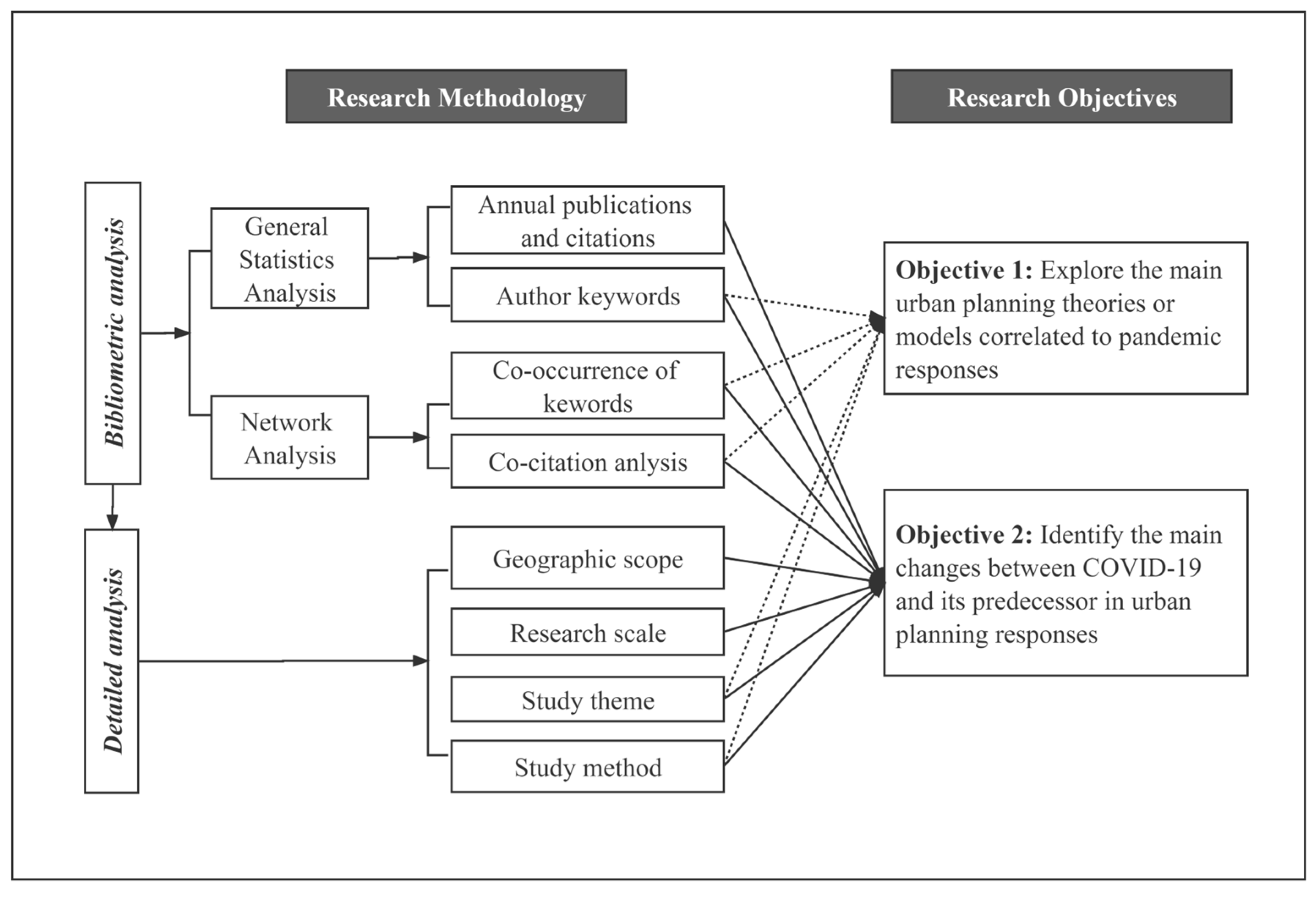

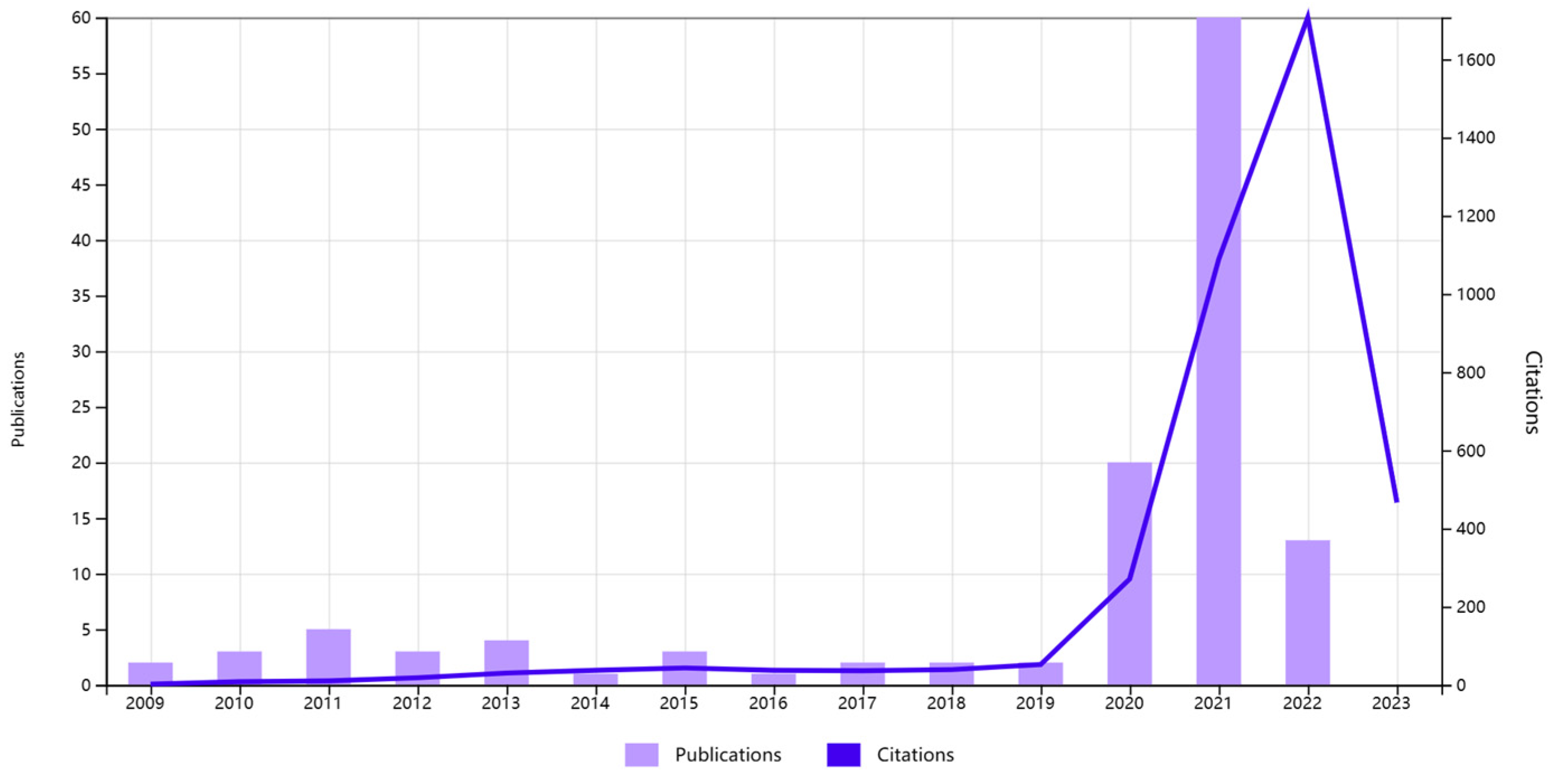
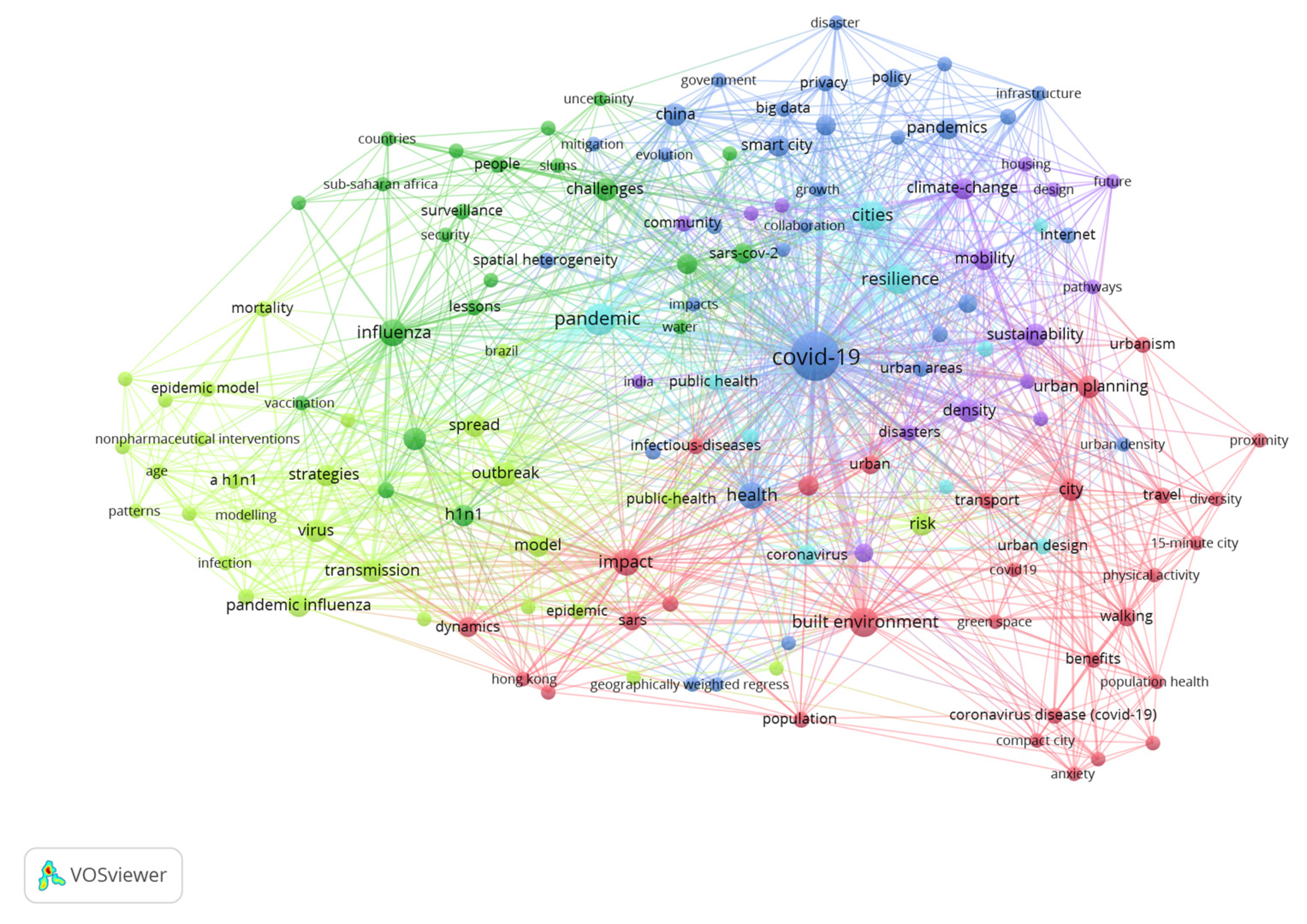
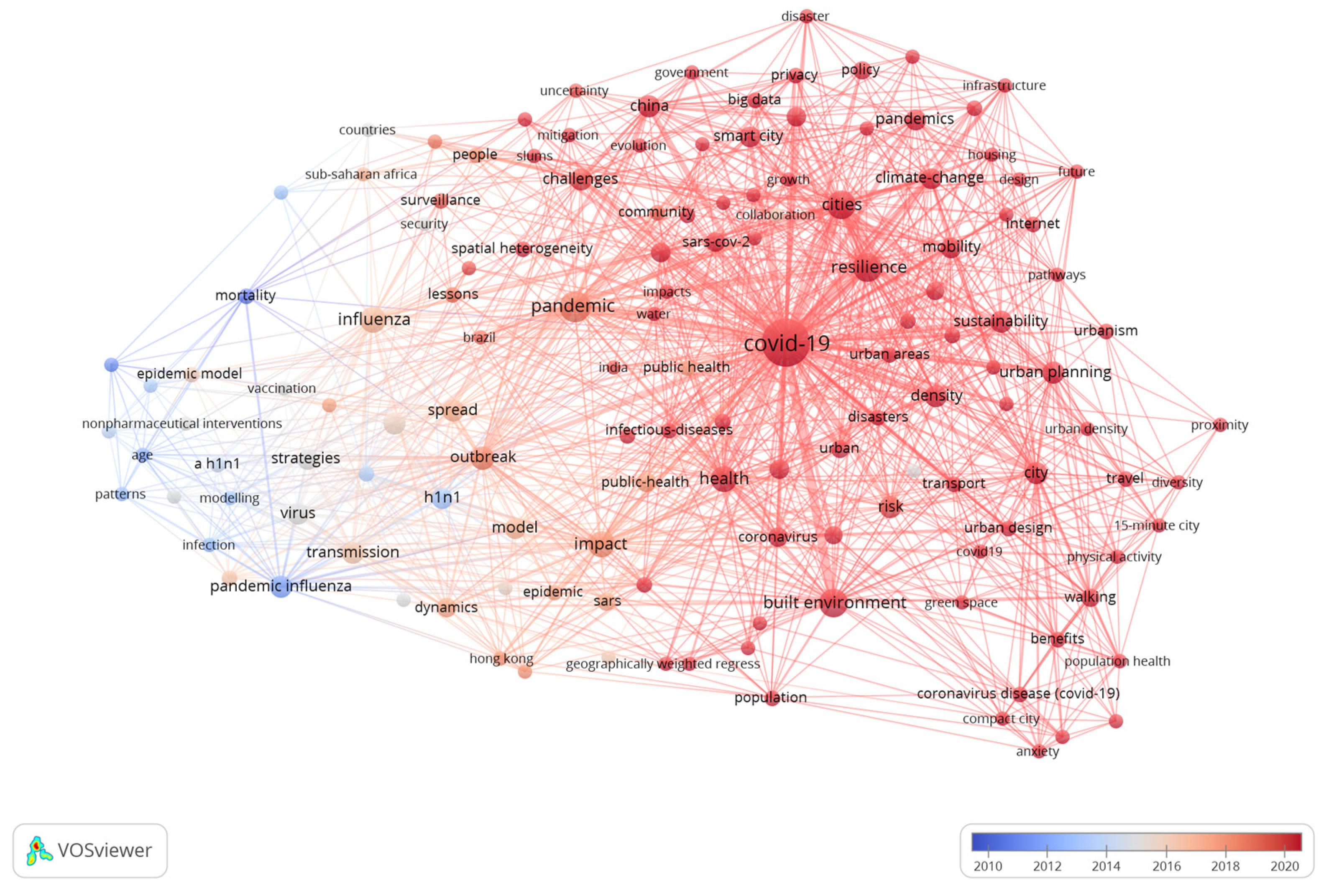

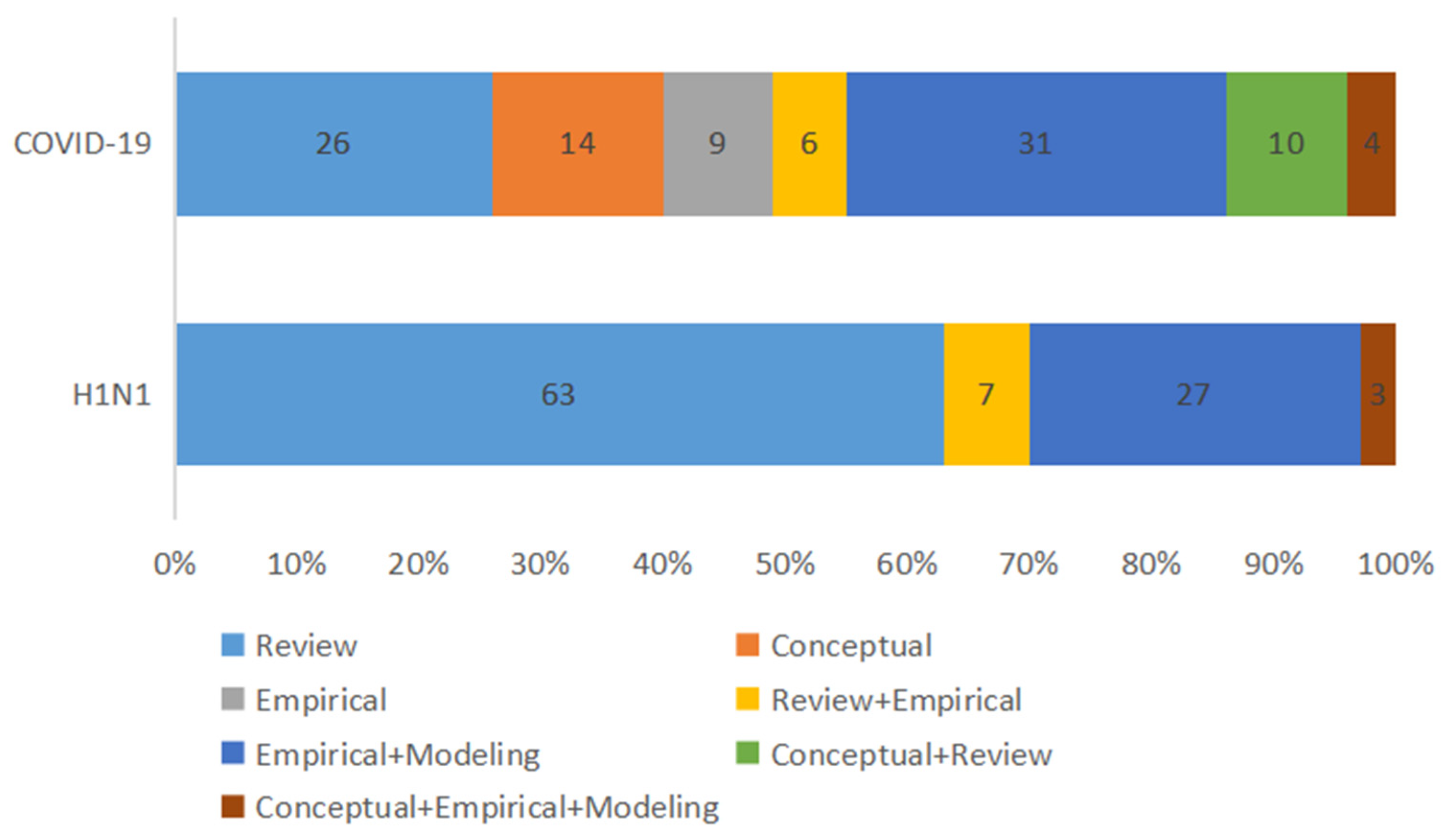
| Rank | Title | Co-Citations | Ideas |
|---|---|---|---|
| 1 | The COVID-19 pandemic: Impacts on cities and major lessons for urban planning, design, and management [28] | 22 | COVID-19 offers great opportunities for planners and policy makers to make transformative actions |
| 2 | Does Density Aggravate the COVID-19 Pandemic? Early Findings and Lessons for Planners [29] | 20 | Planners should continue to promote dense development |
| 3 | Antivirus-built environment: Lessons learned from COVID-19 pandemic [30] | 17 | An antivirus-built environment paradigm is needed |
| 4 | The effect of human mobility and control measures on the COVID-19 epidemic in China [31] | 15 | Shows how control measures implemented in China mitigated the spread of COVID-19 |
| Study Theme | Group | Percentage (%) | Occurrence of Urban Theory Keywords | |||||||||||
|---|---|---|---|---|---|---|---|---|---|---|---|---|---|---|
| Resilience | Smart Cities/City | Sustainability | Vulnerability | Healthy City | 15-min City | Compact city | Temporary Urbanism | Informal Urbanism | Tactical Urbanism | Livable City | Weberian City | |||
| Governance policy | H1N1 | 57 | 1 | 1 | ||||||||||
| COVID | 13 | 3 | 6 | 1 | ||||||||||
| Built environment | H1N1 | 0 | ||||||||||||
| COVID | 10 | 2 | 1 | |||||||||||
| Modeling | H1N1 | 33 | ||||||||||||
| COVID | 10 | 1 | 1 | 1 | ||||||||||
| Socioeconomic factors | H1N1 | 10 | ||||||||||||
| COVID | 32 | 5 | 1 | 1 | 4 | 1 | ||||||||
| Post COVID planning | H1N1 | 0 | ||||||||||||
| COVID | 35 | 9 | 5 | 5 | 1 | 2 | 3 | 1 | 1 | 1 | 1 | 1 | ||
| Total | H1N1 | 1 | 1 | |||||||||||
| COVID | 20 | 12 | 9 | 5 | 3 | 3 | 2 | 1 | 1 | 1 | 1 | |||
Disclaimer/Publisher’s Note: The statements, opinions and data contained in all publications are solely those of the individual author(s) and contributor(s) and not of MDPI and/or the editor(s). MDPI and/or the editor(s) disclaim responsibility for any injury to people or property resulting from any ideas, methods, instructions or products referred to in the content. |
© 2023 by the authors. Licensee MDPI, Basel, Switzerland. This article is an open access article distributed under the terms and conditions of the Creative Commons Attribution (CC BY) license (https://creativecommons.org/licenses/by/4.0/).
Share and Cite
Tu, K.; Reith, A. Changes in Urban Planning in Response to Pandemics: A Comparative Review from H1N1 to COVID-19 (2009–2022). Sustainability 2023, 15, 9770. https://doi.org/10.3390/su15129770
Tu K, Reith A. Changes in Urban Planning in Response to Pandemics: A Comparative Review from H1N1 to COVID-19 (2009–2022). Sustainability. 2023; 15(12):9770. https://doi.org/10.3390/su15129770
Chicago/Turabian StyleTu, Kangwei, and Andras Reith. 2023. "Changes in Urban Planning in Response to Pandemics: A Comparative Review from H1N1 to COVID-19 (2009–2022)" Sustainability 15, no. 12: 9770. https://doi.org/10.3390/su15129770
APA StyleTu, K., & Reith, A. (2023). Changes in Urban Planning in Response to Pandemics: A Comparative Review from H1N1 to COVID-19 (2009–2022). Sustainability, 15(12), 9770. https://doi.org/10.3390/su15129770





